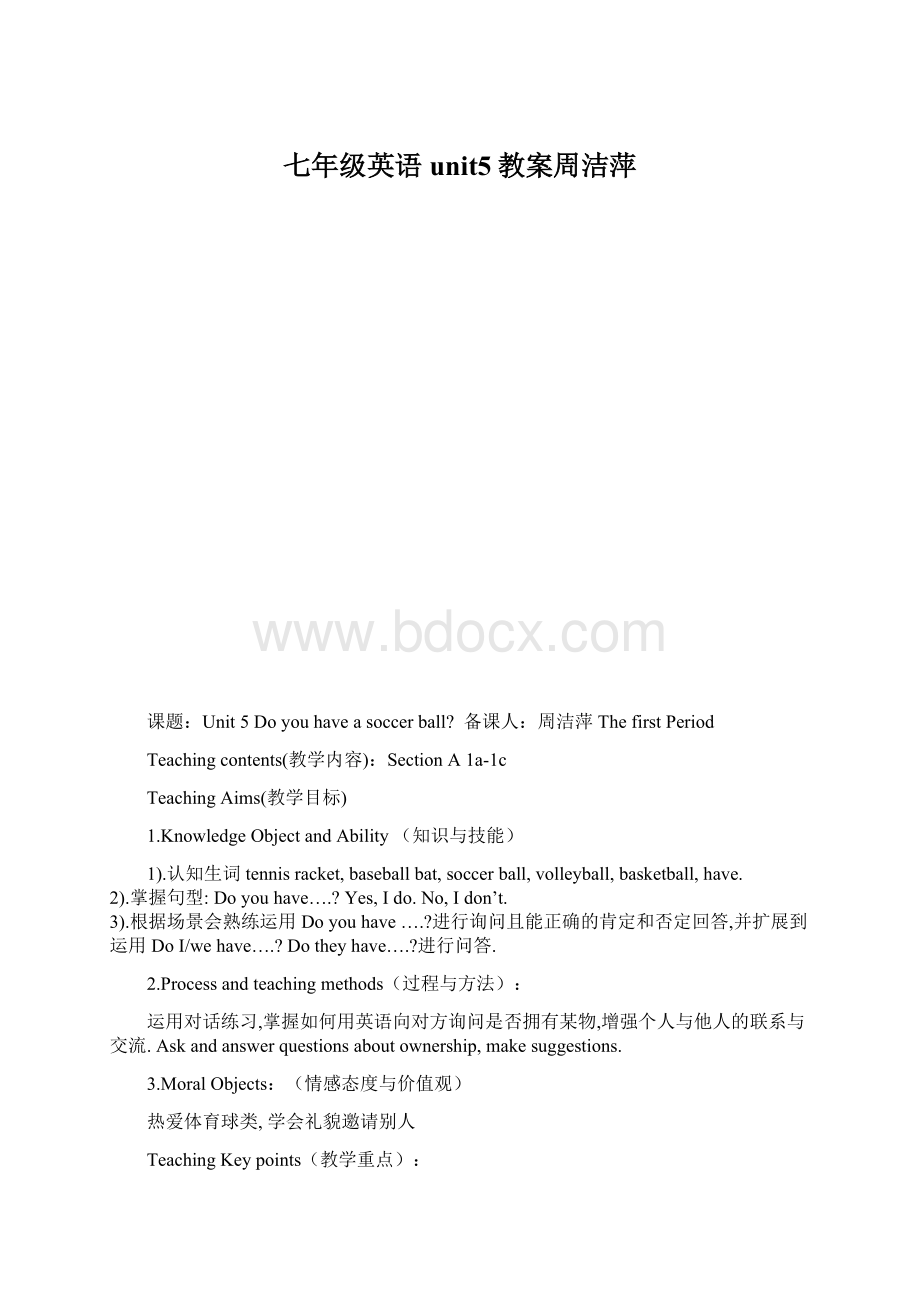七年级英语unit5教案周洁萍.docx
《七年级英语unit5教案周洁萍.docx》由会员分享,可在线阅读,更多相关《七年级英语unit5教案周洁萍.docx(20页珍藏版)》请在冰豆网上搜索。

七年级英语unit5教案周洁萍
课题:
Unit5Doyouhaveasoccerball?
备课人:
周洁萍ThefirstPeriod
Teachingcontents(教学内容):
SectionA1a-1c
TeachingAims(教学目标)
1.KnowledgeObjectandAbility(知识与技能)
1).认知生词tennis racket, baseball bat, soccer ball, volleyball, basketball, have.
2).掌握句型:
Do you have….?
Yes, I do. No, I don’t.
3).根据场景会熟练运用Do you have ….?
进行询问且能正确的肯定和否定回答,并扩展到运用Do I/we have….?
Do they have….?
进行问答.
2.Processandteachingmethods(过程与方法):
运用对话练习,掌握如何用英语向对方询问是否拥有某物,增强个人与他人的联系与交流.Ask and answer questions about ownership, make suggestions.
3.MoralObjects:
(情感态度与价值观)
热爱体育球类, 学会礼貌邀请别人
TeachingKeypoints(教学重点):
1.学习并掌握词汇:
tennis racket, baseball bat, soccer ball, volleyball, basketball, have.
2.学习并掌握句型:
Do you have…?
Yes, I do./No, I don’t.
Teachingdifficultpoints(教学难点):
have 的一般疑问句用法(用于第一、二人称和第三人称的复数)及其肯定和否定回答
Teachingmethods(教学方法):
RoleplayingPairworkDemonstrationmethod
TeachingAids(教学用具):
Tape-recorder,pictures,objects
Classhour(课时):
One
TeachingDate(授课日期):
第_____周星期____月___日
BlackboardDesign(板书设计)
Unit5Doyouhaveasoccerball?
Do you haveasoccerball?
Yes, I do. /No, I don’t.
tennis racket, baseball bat, soccer ball,
volleyball, basketball
Teachingprocedure(教学过程):
StepOne:
Warmingup.Greeting, sing an English song together
ReviewthesentencestructureandthewordsinUnit4:
Makeconversationsabout“where-questions.”Suchas“WhereistheTV?
T:
Whereisyourbackpack?
S:
It’sinthedesk.
T:
Whereareyourpencils?
S2:
Theyareinmypencil-case.
StepTwo:
Newwords
Thisactivityintroducesthekeyvocabulary
1.PresenttheNewwords.(show a soccerball).
Ask the student:
What’s this?
It’s a ball. It’s a soccer ball.
Is this your soccer ball?
No, it isn’t.
Do you have a soccer ball?
Yes./No.
What’s this?
It’s volleyball.
Is this your volleyball?
No, it isn’t.
Do you have a volleyball?
Yes./No.
Inthisperiod,askballsasmanyaspossible.suchas:
volleyball,badminton,pingpong,basketball,football,soccerballthatstudentsareinterestedin.
MakesuresomeofstudentsaregoodatplayingballsandIamsuretheycantalkmorethanteachers.So,askthemtotalkmore,Don’tcareabouttheyspeakEnglishorChinese.It’sveryimportanttomakeourclasslively.
Atthismoment,ask“Doyouhavefootball?
”Helpthemanswer“Yes,IdoorNo,Idon’t”
(Writedownthesentenceontheblackboard.)
2.LearntheNewwords.
show a picture to study the new words:
tennis racket, baseball bat, soccer ball, volleyball,basketball, television
学习方法:
先用图片认知单词,然后领读,注意讲解单词拼写和读音之间的联系,渗透音标教学.再用熟识的句型练习运用这些单词,让学生在不知不觉中达到熟识程度。
利用图片或realballs,beginnewwords,paymoreattentioninpronunciation.ifpossible,wehadbetterwrite音标。
注重发音。
Readthewordsaloud,makesuretheycanspeakwell.
如:
What’s this ?
It’s a tennis racket.
Is this your volleyball?
Yes, it is.
Do you have a volleyball?
Yes,Ido./No,Idon’t.
StepThree:
1a
Thisactivityprovidespracticeinrecognizingspecificvocabularywordsinspokenconversation,andpracticelistening
First do the exercises:
1a (P25) Match the words with the things in the picture.
Keys:
1. c 2. a 3. e 4. f 5. d 6. b
Listen to 1b (P25) and finish the exercise.
Thenchecktheanswers.
Makesentences with the new words to practice the structure:
Do you have….?
Yes, I do. No, I don’t.
StepFour.Pairwork
Practiceinpairs:
Doyouhavea…?
Yes,Ido.NoIdon’t.
Ifpossible,makeconversationlikethis:
What’sthis?
It’sabasketball.Isthisyourbasketball?
No,itisn’t.Doyouhaveabasketball?
No,Idon’t.themore,thebetter.
师生先进行对话,然后生生对话,可以用实物,也可以用图片,还可以用周围的事物.
Do you have….?
Yes, I do. No, I don’t.
Do the following pairwork:
1c (P25) Pairwork
Let the students ask and answer each other:
Do you have a baseball?
Yes, I do. No, I don’t.
3 (P26) Pairwork
look at the things in the picture.
Ask your partner if heorshe has these things with“Do you have a ….?
Yes, I do.”
Listen to 2a (P26) and 2b(P26), then finish the exercises.
Step five. 现场调查
Thestudents ask their partners if he or she has a pen,a ruler, a sharpener and so on. 让每个学生都参与到这个活动来,人人都有表现的机会。
Step6. Summary
Let the students sum up what we have learned this class. Then ask what they haven’t understood.
Step 7. Homework 口语练习:
问你的父母,兄弟姐妹和你的好朋友是否有…..,然后把它记录下来.遇到的生词可以查词典,然后写到你的单词积累本上.
教学反思:
ThesecondPeriod
Teachingcontents(教学内容):
SectionA2a-3
TeachingAims(教学目标)
1.KnowledgeObjectandAbility((知识与技能)
1 掌握生词television, has, does, doesn’t, collection, but, play sports, only, them, small, every, day, every day.
2.掌握句型Does he have ….?
Does she have….?
及回答.
3.根据场景询问, 熟练应用句型进行交际.
2.Processandteachingmethods(过程与方法):
利用录音,教学图片来开展课堂pairwork问答式的交际活动,是学生进一步学会基本句型“Does he have ….?
Does she have….?
及回答.”
3.MoralObjects(情感态度与价值观):
该部分学习内容贴近学生的生活,谈论同学是否拥有各种体育用品.
TeachingKeypoints(教学重点):
1学习并掌握词汇:
television, has, does, doesn’t, collection, but, play sports, only, them, small, every, day, every day.
2学习并掌握句型:
Does he have ….?
Does she have….?
及回答.
Teachingdifficultpoints(教学难点):
区分第三人称单数的用法.
Teachingmethods(教学方法):
听说练
TeachingAids(教学用具):
Recorder,blackboard,pictures
Classhour(课时):
One
TeachingDate(授课日期):
第___周 星期______月_____日
BlackboardDesign(板书设计):
Unit5Doyouhaveasoccerball?
Do you have….?
Yes, I do.// No, I don’t.
Does he/she have …?
Yes,he/shedoes.//No,he/shedoesn’t.
TeachingProcedure(教学过程)
StepOne:
Greeting:
Checkthehomework.
Revise:
Doyouhaveatennisracket?
Doyouhavea….?
Andsomewordslearnedlastperiod,suchastennis,volleyball,ping-pongsoccerball….
StepTwo:
Presentation
(to a boy) Do you have a pen?
Yes, I do.
(to other students) Does he have a pen?
Yes, he does.
(to a girl) Do you have a knife?
No, I don’t.
( to other students) Does she have a knife?
No, she doesn’t.
学习单词:
does, doesn’t, has, television (将单词板书,解释does, doesn’t 是do, don’t的第三人称单数,has 是have的第三人称单数,解释何为第三人称单数,以及它的用法)
StepThree:
Practicethedrills.
A.Listentotheconversation:
Tellthestudentsthattheywillheartheconversationsinthepictures.Playtherecordingthefirsttime.Studentslistenonly.Playagainforstudentstonamethepictures(1-4)
(Playthetapeagainandchecktheanswer.)
T:
Whocananswer?
通过听力。
我们了解Doesyourbrotherhaveasoccerball?
No,hedoes.让学生观察doesanddo的用法。
B.show a picture. (some balls)
Please make a dialogue with “Does he/she have…?
Yes, he/she does.
No, he/she doesn’t.”
Jane
Mike
Barry
Peter
baseball
√
basketball
√
√
Soccerball
√
volleyball
√
Step FourWrite four questions with Do you have?
Find people in the class who has thesethings. Write their names.
然后再将这些句子转换成他/她有 ……吗?
练习两种句型 Do you have…..?
Does he/ she have….?
Step Five. Do the exercises
3a (P29) Read the magazine article. Circle the sports things.
Keys:
tennis rackets, basketballs, baseballs, soccer balls, volleyballs
出现的生词:
collection, but, play sports, only, them 要求学生会读,认知其意义,当堂不必要求会拼写,可放到课后。
3b (P29) Look at the picture. Fill in the blanks in this magazine article about Sue Swanson.
出现的生词:
small, every, day, every day. 要求学生认知并记住。
(small 可补充其反义词big, every 可补充其他短语,如every morning, every Sunday, every student等)
3a, 3b 这两个题目是阅读类型,可让学生先按照要求去完成任务,然后让他们朗读全文,把握其全意,增强语感。
3c (P29) Write about sports things and other things you have.
本题目是复习生词,并扩展学生的词汇量,鼓励他们去接触新的单词。
StepSix:
Presentthegrammarandpractice.
look back (Grammar Focus)
Let the students sum up what we have learned this class. Look at the grammar focus:
Do you have a TV?
Yes, I do. No, I don’t.
Do they have a computer?
Yes, they do. No, they don’t.
Does he have a tennis racket?
Yes, he does. No, he doesn’t.
Does she have a soccer ball?
Yes, she does. No, she doesn’t.
Does Chi-Young have a baseball?
Yes, hedoes. No, he doesn’t.
总结句型,强调人称的变化和助动词的变化。
Then ask what they haven’t understood.Reviewthegrammarbox.Askstudentstosaythequestionsandanswers.Pointout“have–questionwithdoordoes”Doyouhaveapingpongball?
Yes,Ido.No,Idon’t.don’t=donot/doesn’t=doesnot.
(Thentheteacherwritesthesentencesontheblackboard.)
StepSeven.Summary
TodaywehavelearntWhere’ssentencesandhowtoanswer,andlearntotidyyourroom.
StepSeven.Homework:
口语练习:
向你的同桌询问, Mike是否有字典?
Kate 是否有钢笔?
Jane是否有新自行车?
等等,然后把你的句子记录下来
教后感:
ThethirdPeriod
Teachingcontents(教学内容):
SectionA3a-SectionB2c
TeachingAims(教学目标)
1.KnowledgeObjectandAbility(知识与技能)
:
1. 掌握生词let, us, let’s, play, well, sound, good, welcome
our, sport, center, like, we, many, club, ping-pong, more, join, class, interesting, boring, fun, difficult, relaxing, watch TV. (重点词汇:
let, us, let’s, play, well, sound ,good)
2. 认知句型:
Let’s … That sounds good. 会用它向别人提出建议。
3. 会用句型I (We, You, They) have…. He(She, Kate, Jane) has…. 及否定句自由表达。
2.Processandteachingmethods(过程与方法):
利用录音,教学图片来开展课堂pairwork问答式的交际活动
3.MoralObjects(情感态度与价值观):
训练学生的听说能力,增强学生的合作交流意识。
TeachingKeypoints(教学重点):
1.Newword:
let, us, let’s, play, well, sound, good, welcome
our, sport, center, like, we, many, club, ping-pong, more, join, class, interesting, boring, fun, difficult
2.Targetlanguage:
Let’s … That sounds good.
Teachingdifficultpoints(教学难点):
Let’s … That sounds good. 会用它向别人提出建议。
Teachingmethods(教学方法):
Practicing,Listening,reading,speaking,pairwork..
TeachingAids(教学用具):
Recorder,blackboard,cards,picture
Classhour(课时):
One
TeachingDate(授课日期):
第___周 星期________月______日
BlackboardDesign(板书设计):
Unit5Doyouhaveasoccerball?
Let’splayfootball.
Let’s=Letus
Thatsoundsgood/great.
=Thatisgood/great.
interesting, boring, difficult, relaxing,fun
TeachingProcedure(教学过程)StepOne:
Leading-in
Revisetheconversationbypracticethedetailsinlastperiod.M